Medion WIM 2000, WID 2000, WAD 2000 user Manual
NOTEBOOK
COMPUTER
MANUAL

MAKING COPIES OF THIS MANUAL
This manual contains information protected by law. All rights are reserved. Copyright law prohibits duplicating this information in mechanical, electronic, or any other form, without the written approval by the manufacturer.
© 2003. All rights reserved. Microsoft®, MS-DOS®, and Windows® are registered trademarks of Microsoft Corporation in the U.S. and other countries and must be acknowledged when used. Pentium® is a registered trademark of Intel Corporation. The names of actual companies and products mentioned herein are the trademarks of their respective owners.
Information in this document is subject to change without notice.
ii

Table of Contents: |
|
Making Copies of This Manual ..................................... |
ii |
INTRODUCTION...................................................................... |
7 |
Notes on This manual ................................................ |
7 |
Audience .............................................................. |
7 |
Finding More Information ........................................... |
8 |
Getting to Know Windows XP ................................... |
8 |
Software Help........................................................ |
9 |
Device Drivers ....................................................... |
9 |
SAFETY ............................................................................... |
11 |
Safety Instructions.................................................. |
11 |
Data Security ...................................................... |
11 |
Operational safety................................................ |
11 |
General Safety Information ................................... |
12 |
Ambient Temperature........................................... |
12 |
CD-ROM/CD-RW/DVD/DVD-RW Drive Safety............ |
13 |
TFT Display Safety ............................................... |
13 |
Power Adapter..................................................... |
14 |
Battery operation................................................. |
15 |
Modem ............................................................... |
16 |
Touch pad........................................................... |
16 |
Cabling............................................................... |
16 |
Set-Up Location ................................................... |
16 |
Important Additional Safety Instructions ................. |
17 |
Upgrades and Repairs........................................... |
17 |
Notes for Service Engineers...................................... |
18 |
MAINTENANCE ..................................................................... |
19 |
Maintenance Instructions ......................................... |
19 |
Cleaning and Care................................................ |
19 |
Care of the TFT Display......................................... |
19 |
Transporting the Notebook .................................... |
20 |
Securing your Notebook........................................ |
21 |
iii

VIEWS OF THE NOTEBOOK..................................................... |
22 |
Open Notebook....................................................... |
22 |
Left Side................................................................ |
22 |
Right Side .............................................................. |
23 |
Rear Side............................................................... |
24 |
Bottom View........................................................... |
25 |
Indicators .............................................................. |
26 |
Hotkeys ................................................................. |
27 |
GETTING STARTED ............................................................... |
28 |
Step 1 ................................................................ |
28 |
Step 2 ................................................................ |
29 |
Step 3 ................................................................ |
29 |
THE WINDOWS XP DESKTOP .................................................. |
30 |
POWER SUPPLY .................................................................... |
32 |
On/Off button......................................................... |
32 |
Power Adapter ........................................................ |
33 |
Battery Operation ................................................... |
33 |
Inserting the Battery ............................................ |
34 |
Removing the battery ........................................... |
34 |
Charging the Battery ............................................ |
35 |
Battery Power...................................................... |
35 |
Power Management ................................................. |
36 |
Standby mode ..................................................... |
36 |
Suspend (hibernate) mode .................................... |
37 |
DISPLAY.............................................................................. |
38 |
Opening and Closing the Display ............................... |
38 |
Screen Resolution ................................................... |
38 |
Connecting an External Monitor................................. |
39 |
Connecting a TV...................................................... |
41 |
DATA ENTRY ........................................................................ |
44 |
The Keyboard ......................................................... |
44 |
Notebook-specific key combinations........................ |
44 |
Touch pad.............................................................. |
45 |
iv

MAIN COMPONENTS .............................................................. |
46 |
The Hard drive ....................................................... |
46 |
Important Directories ........................................... |
47 |
The Optical Drive .................................................... |
48 |
CD-ROM Drive ..................................................... |
48 |
DVD-ROM Drive ................................................... |
48 |
CD-RW/DVD-ROM Combo Drive ............................. |
48 |
DVD-RW/CD-RW Super Combo Drive ...................... |
48 |
Concerning the DVD Writer ...................................... |
49 |
Handling Discs..................................................... |
49 |
Loading a Disc ..................................................... |
50 |
Removing a Disc .................................................. |
50 |
Playing Music CDs ................................................ |
51 |
Playing DVD Movies.............................................. |
51 |
Writing CDs ........................................................... |
52 |
Writing DVDs ......................................................... |
54 |
The Sound Card...................................................... |
55 |
External Audio Ports ............................................. |
55 |
Modem.................................................................. |
56 |
Modem port ........................................................ |
56 |
The Network .......................................................... |
57 |
What is a network? .............................................. |
57 |
Fast Ethernet-Network.......................................... |
57 |
Wireless LAN ....................................................... |
60 |
Memory Cards ........................................................ |
61 |
The PC card Slots.................................................... |
62 |
32-bit CardBus Port.............................................. |
62 |
Use of PC-cards ................................................... |
62 |
Connection Options ................................................. |
64 |
Universal Serial Bus (USB) Port.............................. |
64 |
Parallel Interface.................................................. |
64 |
IEEE 1394 (FireWire®) .......................................... |
64 |
Infrared Interface ................................................ |
65 |
Instructions for Using the IR port ........................... |
65 |
v

SOFTWARE .......................................................................... |
66 |
Digital Signatures.................................................... |
66 |
Windows Activation .............................................. |
67 |
THE BIOS SET-UP-PROGRAM .................................................. |
68 |
Running the BIOS Set-up ......................................... |
68 |
Navigating the BIOS Utility .................................... |
68 |
CUSTOMER SERVICE ............................................................. |
69 |
Data and System Security ........................................ |
69 |
Data Security ...................................................... |
69 |
Maintenance Programs.......................................... |
69 |
Windows® Update ................................................... |
69 |
Troubleshooting ...................................................... |
72 |
Localize the Cause................................................ |
72 |
Additional Support .................................................. |
74 |
Driver Support........................................................ |
74 |
Standards .............................................................. |
75 |
Electromagnetic Compatibility ................................ |
75 |
Electrical Safety ................................................... |
76 |
Ergonomics ......................................................... |
76 |
Supplementary Information ................................... |
76 |
FCC Compliance Statement.................................... |
77 |
Warranty ............................................................... |
78 |
Limitation of Warranty .......................................... |
78 |
Limits of Liability.................................................. |
79 |
Local Law............................................................ |
79 |
INDEX................................................................................. |
80 |
vi

INTRODUCTION
NOTES ON THIS MANUAL
This manual is divided into sections to help you find the information you require. Along with the Table of Contents, an Index has been provided to help you locate information. Please read the chapters “Operational Safety” (page 11 and following) and “Getting started” (page 28 and following).
In addition, many application programs include extensive help functions. As a general rule, you can access help functions by pressing F1 on the keyboard. These help functions are available to you when you use the Microsoft® Windows® operating system or the various application programs.
AUDIENCE
These instructions are intended for both the novice and advanced user. Regardless of the possible professional utilization, this Notebook is designed for day-to-day household use. The functions and applications for use with this Notebook have been designed with the entire family in mind.
DOCUMENT YOUR NOTEBOOK
It is important to document the details of your Notebook purchase in the event you need warranty service. The serial number can be found on the back of the Notebook:
Serial Number ......................................
Date of Purchase ......................................
Place of Purchase ......................................
INTRODUCTION |
|
7 |

QUALITY
We have selected the components in this computer for their high level of functionality, ease of use, safety and reliability.
Through balanced hardware and software design we are able to provide you with an innovative personal computer useful for applications relating to both work and leisure.
We are pleased to welcome you as our newest customer.
SERVICE
We are pleased to provide individualized customer service throughout the life of your Notebook. Please feel free to contact a customer service representative with any questions relating to this Notebook. A separate section on Customer Service is included in this manual, starting on page 69.
FINDING MORE INFORMATION
There are many kinds of help and information for using your PC. This section tells you where to get help with the Microsoft® Windows® XP operating system, software programs, and your Notebook.
GETTING TO KNOW WINDOWS XP
WINDOWS XP MANUAL
This printed manual provides general information about the operating system. We recommend that all beginning users or users of previous versions of Windows read this information. It can be found with the CDs in the accessory box that came with your PC.
WINDOWS XP TOUR
Windows XP includes a tour that you can take to familiarize yourself with the operating system. This tour can usually be found by clicking on the Start menu. You can also find the tour by selecting All Programs, then Accessories.
8 |
|
ENGLISH |

WINDOWS XP HELP AND SUPPORT
An answer to almost every question can be found in this program. You’ll find it in the Start menu.
SOFTWARE HELP
Many software programs incorporate extensive help functions. As a general rule, you can access help functions by pressing F1 on the keyboard. Many software programs include Help as an option on the menu at the top of the screen or window. They may also provide an icon (or icons) with a question mark on them that you can click to access more information.
DEVICE DRIVERS
If you install external devices, such as printers or digital cameras, you may also need to install device drivers. The drivers will be included with your peripheral devices. These are occasionally updated by the manufacturer. Check with the manufacturer of your peripheral device to find out if you have the most recent version of your device drivers.
INTRODUCTION |
|
9 |

10 |
|
ENGLISH |
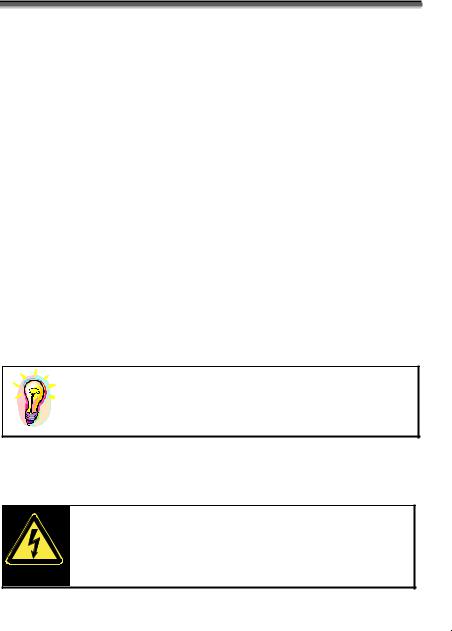
SAFETY
SAFETY INSTRUCTIONS
This manual contains important information on the safe and proper setup, use and care of your Notebook computer. Please read this manual carefully and follow all instructions. These instructions should be kept with your computer at all times. Proper set up, use and care can help extend the life of your Notebook. In the event that you transfer ownership, please provide these instructions to the new owner.
Please follow the instructions in this section for the safe operation of your Notebook:
DATA SECURITY
How important is the information you will be storing on your Notebook? You need to guard against the loss of your data by making backup copies. You can backup your data onto CD, floppy disk, or other media such as Zip drives. It depends upon how much data you have. In this way, if something happens to the hard drive in your Notebook, you have another copy of your data.
The supplier does not assume liability for data loss or damage to data storage units, and no claims can be accepted for damages resulting from the loss of data or consequential losses.
OPERATIONAL SAFETY
It is important to follow all of the safety instructions in this manual to ensure the safety of you and your Notebook.
• DO NOT open the case of the Notebook, the battery or the power adaptor. When the case is open there is a danger of severe electric shock.
SAFETY |
|
11 |
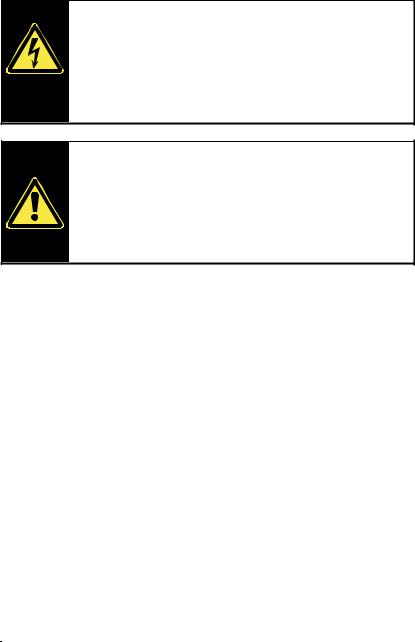
• DO NOT insert objects through the slots and openings of the Notebook. This may lead to electric shock, electrical short-circuit or fire that will damage your Notebook.
•DO NOT allow small children to play unattended with electrical equipment.
• DO NOT cover the slots and openings of the Notebook. These openings are for ventilation purposes. Covering these vents may lead to overheating.
• This Notebook is NOT designed for use within industrial environments.
GENERAL SAFETY INFORMATION
If you find that:
•the power cord/power adapter is worn or damaged.
•liquid is spilled on the unit.
•the Notebook fails to work properly.
•the Notebook is dropped or the housing is damaged.
You should:
•shut-down your Notebook immediately.
•remove the power cord from the socket.
•contact Customer Service.
•do not restart unless you have contacted Customer Service.
AMBIENT TEMPERATURE
•The Notebook is most reliably operated at an ambient temperature between +41° and +104° F and at a relative humidity between 30% and 70% (without condensation).
•When powered off, the Notebook can be stored at temperatures between 32° and 140° F.
12 |
|
ENGLISH |
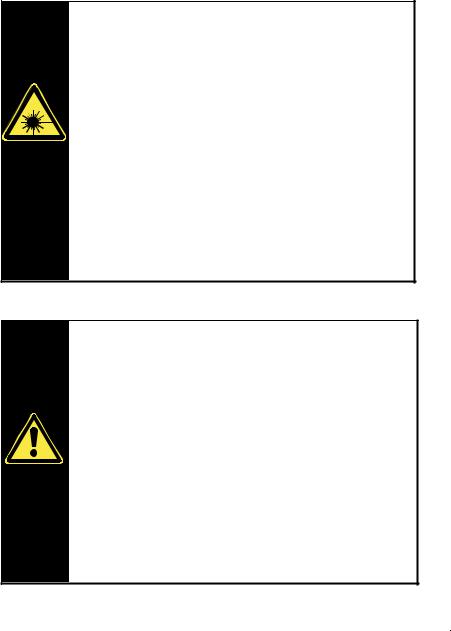
CD-ROM/CD-RW/DVD/DVD-RW DRIVE SAFETY
• CD-ROM-/CDRW-/DVD-drives are Laser Class 1 devices. These lasers must remain in their sealed casing.
• Danger — Invisible laser radiation when open. Avoid direct exposure to beam. This product is certified by the manufacturer to comply with DHHS rules 21CFR, Chapter 1, Subchapter J, applicable at date of manufacturer. Refer to optical drive labels for additional details.
•DO NOT remove the drive covers, as exposure to the lasers may be harmful.
•DO NOT look directly into the laser, even when wearing eye protection.
TFT DISPLAY SAFETY
•To avoid damage to the TFT Display, never open it a full 180º. Do not forcibly open it.
•In order to avoid damage to the display, do not touch it with your fingers or sharp objects.
• Never lift the Notebook by the TFT Display; doing so could break the hinges.
• There is a risk of injury if the TFT display breaks. Use protective gloves to pack up the broken pieces and contact customer service to arrange for proper disposal.
It is important to thoroughly wash your hands after handling a broken TFT display. There is a chance that chemicals may have been released.
SAFETY |
|
13 |

•Never place objects on top of the Notebook that would exert any pressure on the display. There is a danger that even slight pressure may break the TFT display.
POWER ADAPTER
•Do not open the power adapter housing. When the housing is open there is a danger of severe electric shock. It contains no user-serviceable parts.
•The electric outlet must be in the vicinity of the Notebook and within reach of the power adapter cables. DO NOT stretch the power cables tightly to reach an electric outlet.
•To disconnect your Notebook from the power source, or set the Notebook to battery operation, remove the power cord from the Notebook’s power socket.
•Only use the Notebook with a power adaptor (FSP120AAC) operating at AC 115V~/60 Hz. In European countries use the Notebook at AC 220-240V~/50 Hz.
For details on power consumption, please refer to the rating plate on the rear of your Notebook. If you are unsure of the type of power supply available at the point of use, ask your local power company.
•Use only the supplied power cord and power adapter.
•If using an extension cord, make certain that it meets your local safety requirements. If in doubt, consult an electrician.
•To provide additional protection against electric shock, power surges, lightning strikes, or other electrical damage to your Notebook, we recommend the use of a surge protector.
•To avoid possible damage by lightening, don’t use the notebook during lightening storms.
14 |
|
ENGLISH |
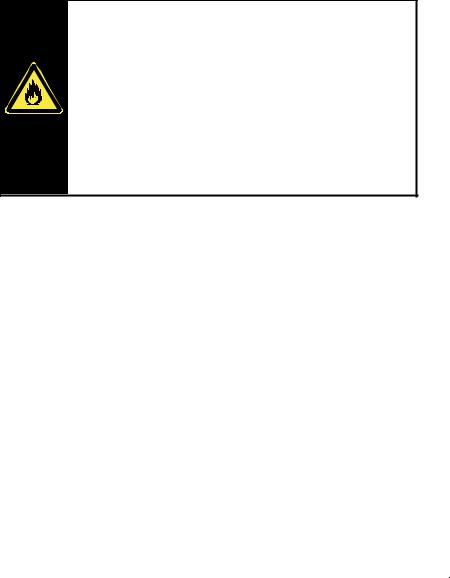
BATTERY OPERATION
To extend the life and power of your battery and guarantee secure operation, the instructions below should be followed:
•Never expose the battery to direct sunlight or heat for long periods.
•Do not dispose of the battery by fire as they
may explode. Check with local codes for possible special disposal instructions.
• Do not open the battery housing; it contains no user-serviceable parts.
•Disregarding these instructions will lead to damage and under some circumstances may even cause the battery to explode.
•Keep the battery away from electrically conductive materials, chemical substances and cleaning agents.
•Only use the originally supplied power adapter to charge the battery (FSP120-AAC).
•Ensure (by indicator or warning tone of the notebook) that the battery is fully discharged before charging again.
•Replace the battery only with the same type or an equivalent type recommended by the manufacturer.
•Charge the battery only until the battery charging light goes out. Also, refer to the instructions under "Charging the Battery" on page 35 for instructions on checking the battery level.
•Only change the battery when the unit is switched off.
•Batteries are classified as special waste and should always be disposed of properly. Contact Customer Service for more details.
•Keep batteries away from children at all times.
•Use only the batteries and power adapter/cord indicated in this manual.
SAFETY |
|
15 |
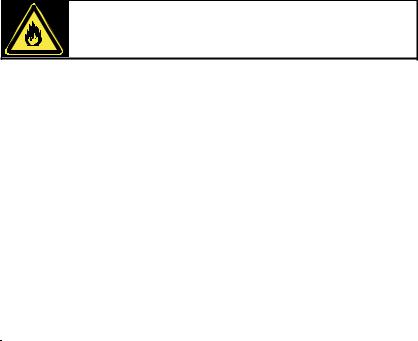
MODEM
•If your system has a modem, please make sure you connect it to an analog telephone line only. Connecting to a digital PBX, a digital line designed for broadband services or ISDN, a shared service line or a payphone will damage the modem or the devices to which it is connected.
TOUCH PAD
•Light pressure with the tip of your finger is all that is required to operate the touch pad. Because the touch pad is electrostatic sensitive, objects cannot be used in place of your fingers. Using a pen or other object can damage the touch pad or cause the Notebook to malfunction.
CABLING
•Arrange cables so no one can walk on or trip over them.
•DO NOT place objects on any of the cables.
Caution – To reduce the risk of fire, use only No. 26 AWG or larger telecommunication cords (applies to American Standards).
SET-UP LOCATION
•Keep your Notebook and all connected peripherals away from moisture, dust, heat and direct sunlight. Failure to do so can lead to Notebook malfunction or damage.
•It is highly recommended you do not use the Notebook outdoors.
•Operate the Notebook and all peripherals on a stable, balanced and vibration-free surface.
•Do not leave the base of your Notebook on your lap or any part of your body for a long period of time while the Notebook is turned ON or is charging. The Notebook can become very warm while it is turned on or charging and can cause discomfort or injury from heat exposure.
16 |
|
ENGLISH |
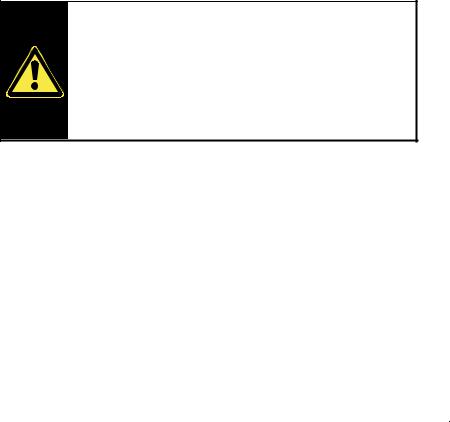
IMPORTANT ADDITIONAL SAFETY INSTRUCTIONS
When using any electronic equipment, basic safety precautions should always be taken. Following the guidelines below can reduce the risk of fire, electric shock and personal injury:
•Do not use this product near water (e.g., near a bathtub, lavatory or kitchen sink, in a wet basement or near a swimming pool).
•Avoid using a telephone/modem (other than a cordless type) during an electrical storm. There is a remote risk of electric shock from lightning.
•Do not use the telephone/modem to report a gas leak in the vicinity of the leak.
Lithium batteries cannot handle intense pressure, high temperatures or fire. Danger of explosion if replaced incorrectly. Replace batteries with a compatible type as recommended by the manufacturer. Lithium batteries are hazardous waste and require proper disposal. Contact the Service Center for additional information on battery disposal.
UPGRADES AND REPAIRS
•Only a qualified Service Engineer should perform upgrades and repairs to your Notebook.
•If you do not have the necessary qualifications, go to an appropriate Service Engineer. Please contact the Service Center if you are experiencing technical problems with your Notebook.
SAFETY |
|
17 |

NOTES FOR SERVICE ENGINEERS
•Before opening the housing, disconnect the Notebook from all power sources and remove any connecting cables. If the Notebook has not been disconnected from the power outlet before being opened, there is a danger of severe electric shock. There is also a risk of damage to the components.
•Internal components of the Notebook may be damaged by electrostatic discharge (ESD). Perform system upgrades and changes in an ESD-protected work area. If no such work area is available, wear an antistatic wrist strap or touch a highly conductive metal object. Your service center can repair damage sustained by inappropriate handling for a fee.
•Use only original spare parts.
CAUTION: The CMOS lithium batteries cannot tolerate intense pressure, high temperatures or fire. Keep away from children! Danger of explosion if replaced incorrectly. Only replace with a compatible type (CR2032) as recommended by the manufacturer. Lithium-Batteries are hazardous waste and need to be disposed of properly. If necessary, we will take back your used CMOS lithium battery.
Notes on Laser Radiation :
Laser devices of Laser Class 1 to Laser Class 3b may be used in the Notebook. Where the Notebook housing remains closed, the device meets the requirements of Laser Class 1. By opening the Notebook housing you will gain access to laser devices of up to Laser Class 3b.
•The CD-ROM/CD-RW/DVD/DVD-RW drive contains no userserviceable parts. Only the manufacturer should perform repairs to the CD-ROM/CD-RW/DVD/DVD-RW drives.
When removing and/or opening laser devices, the following guidelines must be observed:
•DO NOT look into the laser beam, even while wearing optical protection.
•DO NOT allow yourself to be exposed to the laser beam. Avoid exposure of the eyes or skin to direct or stray radiation.
18 |
|
ENGLISH |
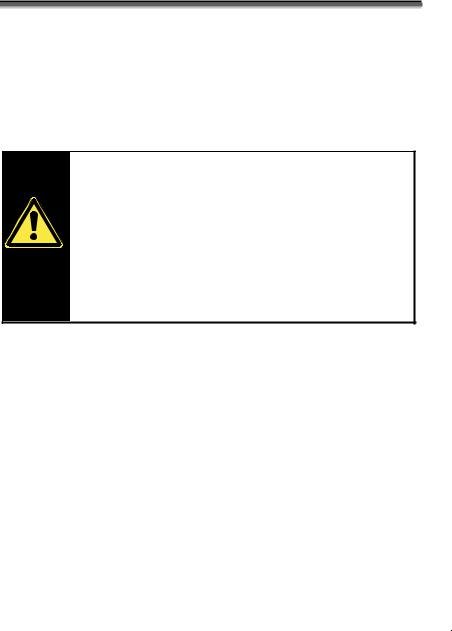
MAINTENANCE
MAINTENANCE INSTRUCTIONS
This section provides information on the proper maintenance and care of your Notebook. Following these measures can extend its lifetime.
CLEANING AND CARE
• Warning! There are no user-serviceable or user-cleanable parts inside the Notebook housing. Never open the Notebook housing.
• DO NOT use any solvents, corrosive or gaseous cleaning agents.
•DO NOT use CD-ROM cleaning disks or similar products that clean the lens of the laser to clean your CD-ROM/CD-RW/DVD/DVD-RW drive.
•Before cleaning, always remove the power adapter plug and all connecting cables.
•Only use a damp, lint-free cloth to clean the Notebook.
CARE OF THE TFT DISPLAY
•Always close the Notebook when not in use. Avoid touching or scratching the surface of the screen as it is easily damaged.
•Make sure that no water drops are allowed to remain on the screen. Water can cause permanent discoloration.
•Clean the screen with a dry, soft, lint-free cloth.
•Do not expose the screen to bright sunlight or ultraviolet radiation.
MAINTENANCE |
|
19 |

TRANSPORTING THE NOTEBOOK
Please use the following guidelines when transporting the Notebook:
•Switch off the Notebook. This will prevent damage to the hard disk. When the Notebook is turned off, the hard disk heads are moved into a safe area.
•Remove any CDs and floppy disks. This will prevent damage to the disks or to the drive heads.
•Close the Notebook and ensure that the cover locks shut.
•Always use the Notebook carrying case. This helps to protect the Notebook from dirt, moisture, jolts and scratches.
•Fully charge your battery and any spare batteries immediately before a long journey.
•Should you need to ship your Notebook, always use the original packaging and make certain the shipper knows the contents contain fragile electronic equipment.
•Wait until the Notebook has reached ambient (room) temperature before turning it on or connecting it to the power adapter. Drastic variations in temperature and humidity can create condensation within the Notebook and may cause it to short-circuit.
20 |
|
ENGLISH |
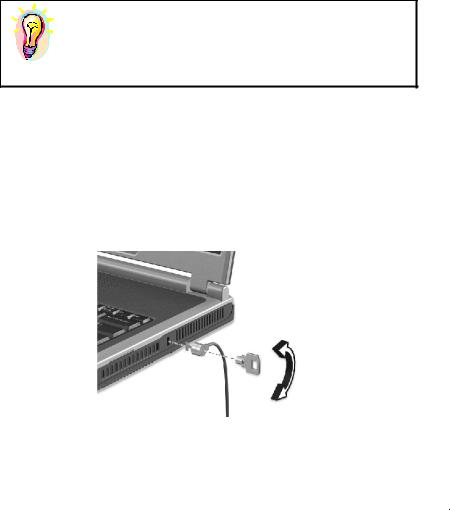
SECURING YOUR NOTEBOOK
SETTING A USER PASSWORD
You can prevent unauthorized access to your Notebook by setting a User Password. If a User Password is set, you will be prompted for the password each time the Notebook is started. The User Password is set in the BIOS (page 68).
Attention: It is important to record your password in a safe place. If you forget your password, you will not be able to cancel it or access the software on your Notebook. If this happens, you will need to contact your service center.
USING A SAFETY LOCK
You can prevent theft by using a special type of lock called a Kensington lock, which can be bought at your local retailer.
A Kensington lock has a cable that wraps around a stationary object and a “T” shaped end that inserts into the Kensington lock port on your Notebook. Either a key or combination dial is used to secure the lock in place.
MAINTENANCE |
|
21 |
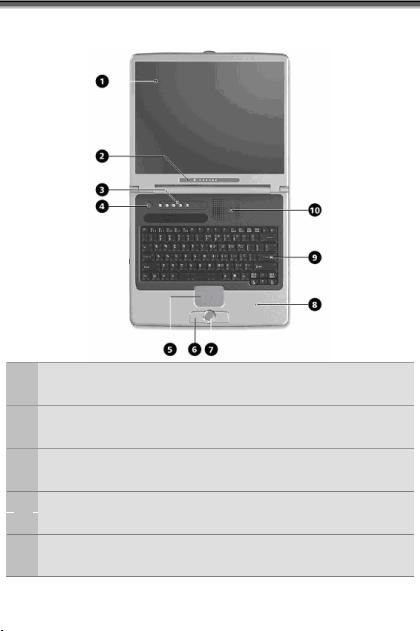
VIEWS OF THE NOTEBOOK
OPEN NOTEBOOK
nTFT display (Ö p. 38)
oStatus-/Operation Indicators (Ö p. 26)
pHotkeys (Ö p. 27)
qPower ON/OFF (Ö p. 32)
rTouch pad (Ö p. 45)
sTouch pad keys (Ö p. 45)
t Touch pad scroll key (Ö p. 45)
uPalm rest
v Keyboard
wFan slot*
*Caution! Do not cover when in use!
22 |
|
ENGLISH |
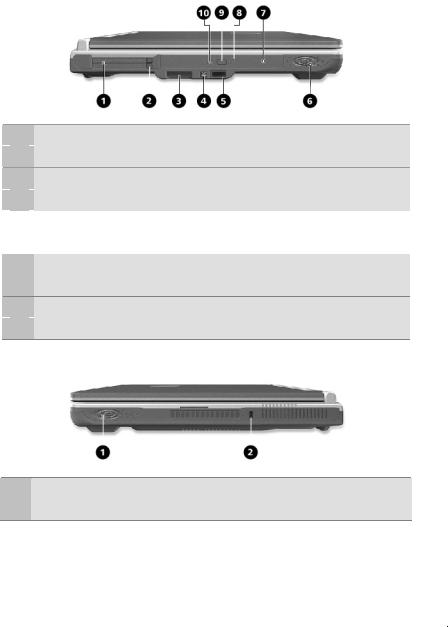
LEFT SIDE
nPC card slot PCMCIA, (Ö p. 62)
oPC card eject button (Ö p. 63)
p3 in 1 card-interface (Ö S. 61)
qIEEE1394 (4-pin) (Ö p. 64)
r |
Infrared port (Ö p. 65) |
|
|
s |
Stereo Speaker |
|
|
tOptical drive
uDisc emergency eject
vDisc eject button (Ö p. 50)
wActivity LED optical drive
RIGHT SIDE
n o
Stereo Speaker
Kensington lock (Ö p. 21)
VIEWS OF THE NOTEBOOK |
|
23 |

REAR SIDE
nPower socket (Ö p. 32)
oParallel port (Ö p. 64)
pTV/Video out (S-Video) (Ö p. 39)
qExternal monitor (VGA) (Ö p. 39)
rUSB port (Ö p. 64)
sLAN port (RJ-45) (Ö p. 57)
tModem port (RJ-11) (Ö p. 56)
uLine out/SPDIF (optical out) (Ö p. 55)
vLine in/Microphone in (Ö p. 55)
24 |
|
ENGLISH |
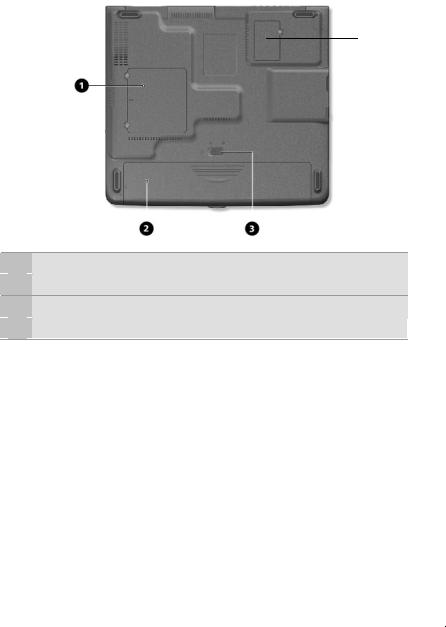
BOTTOM VIEW
q
n Memory compartment o Battery bay (Ö p. 34)
p Battery lock/unlock latch (Ö p. 34) q Modem Cover
VIEWS OF THE NOTEBOOK |
|
25 |
